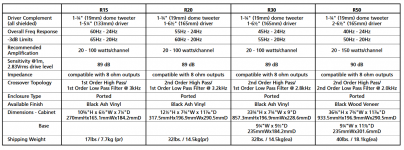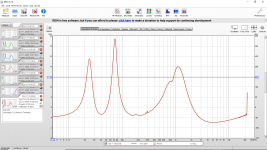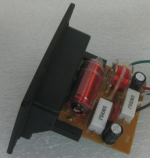Any recommendation on using Vifa 1" ring radiator (XT25TG30-04)
over Vifa 1" (DX25TG05-04) silk dome tweeter?
From here: http://www.tymphany.com/xt25tg30-04
over Vifa 1" (DX25TG05-04) silk dome tweeter?
From here: http://www.tymphany.com/xt25tg30-04
I have used the XT25 and I like it. I have not tried the DX25.
But I can make two comments:
The first one is a bit strange. If one were using the tweeter with a waveguide, the XT25 would work much better. I have had problems with the domes causing a response dip and the DX25 has a dip in the same frequency range even in the flat baffle tests.
Perhaps a more useful suggestion is to look at this web page:
http://www.zaphaudio.com/tweetermishmash/compare.html
Here you can see and compare the responses of the DX25 and XT25. From this, I would pick the XT25 for smoother freq. response and lower harmonic distortion in the listening range. (esp. the odd harmonics)
I am not so keen on the looks of the XT25. But one gets use to it and it does work well.
But I can make two comments:
The first one is a bit strange. If one were using the tweeter with a waveguide, the XT25 would work much better. I have had problems with the domes causing a response dip and the DX25 has a dip in the same frequency range even in the flat baffle tests.
Perhaps a more useful suggestion is to look at this web page:
http://www.zaphaudio.com/tweetermishmash/compare.html
Here you can see and compare the responses of the DX25 and XT25. From this, I would pick the XT25 for smoother freq. response and lower harmonic distortion in the listening range. (esp. the odd harmonics)
I am not so keen on the looks of the XT25. But one gets use to it and it does work well.
Hi
I would recommend the BG version any time.
http://www.madisound.com/catalog/product_info.php?products_id=8402
The TG30 is an old version, and the new BG60 sounds alot better. I never really liked the DX25.
I would recommend the BG version any time.
http://www.madisound.com/catalog/product_info.php?products_id=8402
An externally hosted image should be here but it was not working when we last tested it.
The TG30 is an old version, and the new BG60 sounds alot better. I never really liked the DX25.
Hi
Maybe I am wrong, but isn't it DX25 very similar to the tweeter emploied in the big ProAc? 😕
Cheers,
Paolo
Maybe I am wrong, but isn't it DX25 very similar to the tweeter emploied in the big ProAc? 😕
Cheers,
Paolo
I know is this an old thread but I need some advice on the VIFA XT25TG30-04. Does anyone know if this would be a good upgrade to the tweeter in the Polk R50?
Does anyone have experience with upgrading the tweeter in the Polk R50? If there is a highly successful replacement please let me know which brand and model worked well.
Does anyone have experience with upgrading the tweeter in the Polk R50? If there is a highly successful replacement please let me know which brand and model worked well.
Why would you swap a tweeter in a design that was designed around it ?
Certainly hard to answer without knowing the spec of the original Polk tweeter and the filter typology & cut-off frequency... But being affordable, if the sensivity is matched, you don't take huge risks to try it.
Certainly hard to answer without knowing the spec of the original Polk tweeter and the filter typology & cut-off frequency... But being affordable, if the sensivity is matched, you don't take huge risks to try it.
To improve it. I have heard that dual ring radiator tweeters have lower distortion. The tweeter in the R50 is pretty low cost looking and I was would like to know what the higher end tweeters sound like. Polk has used them in much higher end speakers than the R50.
I am not terribly daunted about the R50 being designed around the tweeter. I did my first tweeter (and then crossover) swap thirty years ago. That was in a cheap Fisher 2 Way with an 8 inch woofer and a horrific piezo tweeter with nothing for a crossover. I did a little research into the impedances, response curves, sensitivities, likely crossover points, etc. Then I bought my first textile dome tweeter and 2 way crossover to match. It was an absolute night and day improvement over the stock configuration.
I still enjoy modifying or building new whether it be amplifiers or speakers. At this point I have a good collection of crossover caps, adjustable (L) pads, power resistors, etc.
My main system was upgraded twice since I bought the R50's about 15 years ago. Now I use them in my basement to test and modify my project amplifiers. I have already upgraded the crossover capacitors and now I would like to see what a lower distortion tweeter might do. The little NP electrolytic capacitors I removed still measure "ok" after 15 years and lots of use. Obviously not as nice as the film capacitors that replaced them but not bad for such cheap small caps after 15 years.
One 3/4" (19mm) dome tweeter, Two 6 1/2" (165mm) driver
Sensitivity @1m, 2.83Vrms drive level: 90 dB
Crossover Topology 2nd Order High Pass 2nd Order Low Pass Filter @2.0kHz
The capacitors I replaced with film caps were 5.8uF and 12uF.
I have attached the specifications from Polk, a photo of the crossover and the impedance curve I measured with REW. Polk says "compatible with 8 Ohms" but they are most definitely 4 Ohms. The two 6 1/2" drivers are 2 Ohms each and are connected in series.
I am not terribly daunted about the R50 being designed around the tweeter. I did my first tweeter (and then crossover) swap thirty years ago. That was in a cheap Fisher 2 Way with an 8 inch woofer and a horrific piezo tweeter with nothing for a crossover. I did a little research into the impedances, response curves, sensitivities, likely crossover points, etc. Then I bought my first textile dome tweeter and 2 way crossover to match. It was an absolute night and day improvement over the stock configuration.
I still enjoy modifying or building new whether it be amplifiers or speakers. At this point I have a good collection of crossover caps, adjustable (L) pads, power resistors, etc.
My main system was upgraded twice since I bought the R50's about 15 years ago. Now I use them in my basement to test and modify my project amplifiers. I have already upgraded the crossover capacitors and now I would like to see what a lower distortion tweeter might do. The little NP electrolytic capacitors I removed still measure "ok" after 15 years and lots of use. Obviously not as nice as the film capacitors that replaced them but not bad for such cheap small caps after 15 years.
One 3/4" (19mm) dome tweeter, Two 6 1/2" (165mm) driver
Sensitivity @1m, 2.83Vrms drive level: 90 dB
Crossover Topology 2nd Order High Pass 2nd Order Low Pass Filter @2.0kHz
The capacitors I replaced with film caps were 5.8uF and 12uF.
I have attached the specifications from Polk, a photo of the crossover and the impedance curve I measured with REW. Polk says "compatible with 8 Ohms" but they are most definitely 4 Ohms. The two 6 1/2" drivers are 2 Ohms each and are connected in series.
Attachments
Last edited:
Piezo tweeters don't actually need a crossover, which is one of the reasons why they are used in relatively cheap speakers.
If the Polk's are well designed then a tweeter swap will require crossover modification. To do this you'll need to measure the speakers etc to end up with good results. Otherwise it's pot luck.
If the Polk's are well designed then a tweeter swap will require crossover modification. To do this you'll need to measure the speakers etc to end up with good results. Otherwise it's pot luck.
A good implementation of the Vifa XT25 tweeter.
Test Peerless XT25TG-30 / 04 at Waveguide WG-300
Regards.
Test Peerless XT25TG-30 / 04 at Waveguide WG-300
Regards.
Thank you. That is a nice set of measurements. The sound pressure level tapers off more than I expected.
The set of distortion measurements with PSL are quite informative also.
I was going to make a Panasonic measurement microphone for REW but then I discovered that those elements were discontinued long ago. I guess I could consider something like the Dayton Audio iMM-6 Calibrated Measurement Microphone for Tablets iPhone iPad and Android. Otherwise I will be limited to published specifications and ear.
The set of distortion measurements with PSL are quite informative also.
I was going to make a Panasonic measurement microphone for REW but then I discovered that those elements were discontinued long ago. I guess I could consider something like the Dayton Audio iMM-6 Calibrated Measurement Microphone for Tablets iPhone iPad and Android. Otherwise I will be limited to published specifications and ear.
- Home
- Loudspeakers
- Multi-Way
- Any recommendation on using Vifa 1" ring radiator (XT25TG30-04)


